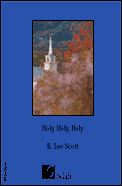|
|
 |
Holy, Holy, Holy
Composer K. Lee Scott
Text Isaiah 6:3; hymn text Reginald Heber, 1827, alt.
Voicing SATB, organ, opt. cong., brass quartet, timpani and percussion
Topics Opening of Worship, Praise and Adoration
Church Season Trinity
Length 4' 10" Price $2.75 (U.S.) Released 5/00
Catalog no. 425-612 Difficulty Moderately difficult
Discography Fill the World with Loudest Praise, St. Paul's Chamber Choir, Robert Brewer, conductor (Selah 520-425)
Order now!
Order PDF download!
Other Editions Conductor's Score/Parts Price $20 (U.S.)
Order Cond. Score/Parts


Read a history of the hymn
Download a review copy of this anthem
 Description Description
An expansive arrangement of the tune NICAEA for SATB, congregation, brass quartet, percussion, and timpani. Splashy, colorful, and highly dramatic, Scott's choral writing is direct and straightforward, requiring no divisi. A wonderful opening hymn for a festive service of worship. A good organist could perform this without the brass.
Text
Holy! Holy! Holy! O LORD God Almighty!
Heaven and earth are full of thy glory!
Holy, holy, holy, Lord God almighty!
Early in the morning our song shall rise to thee:
holy, holy, holy, merciful and mighty,
God in three persons, blessed Trinity!
Holy, holy, holy! All the saints adore thee,
casting down their golden crowns around the glassy sea;
cherubim and seraphim falling down before thee,
which were, and art, and evermore shalt be.
Holy, holy, holy! Though the darkness hide thee,
though the eye of sinfulness thy glory may not see;
only thou art holy; there is none beside thee,
perfect in power, in love, and purity.
Holy, holy, holy! Lord God almighty!
All thy works shall praise thy name in earth and sky and sea;
holy, holy, holy, merciful and mighty,
God in three persons, blessed Trinity!
--Isaiah 6:3; hymn text Reginald Heber, 1827, alt.
History of the hymn
Reginald Heber, an Anglican clergyman, wrote the hymn "Holy, Holy, Holy" for use on Trinity Sunday, the Sunday after Pentecost. Part of Heber's collection of hymns for use with the Anglican Church calendar, "Holy, Holy, Holy" was acclaimed by the British Poet Laureate, Alfred, Lord Tennyson, as "the world's greatest hymn." It is perhaps the best known of more than 50 hymn texts by Heber. (Others include "From Greenland's Icy Mountains," and "Brightest and Best of the Sons of the Morning.")
The son of an Anglican rector, Heber came from an illustrious Tory family noted through generations for loyalty to Church and crown. During his years at Oxford, he distinguished himself in the study of Latin and Greek and was elected in 1804 a Fellow of All Souls College. He cultivated his interest in literature and writing in correspondence with Sir Walter Scott, Robert Southey and others but devoted most of his time to the study of theology. Ordained in 1807, Heber was appointed by his older brother to the church at Hodnet, his family living. In Hodnet, Heber wrote his hymns.
Heber made congregational singing a priority. An Anglican with impeccable theological and social credentials, he helped make congregational song respectable in the Anglican Church. Dismayed by the quality and apparent irrelevance of psalm singing to the sermon and liturgy, he began writing and collecting hymns with the goal of preparing a hymnal organized around the Church of England's Church Year. He sought (unsuccessfully) official sanction for a collection of hymns. Heber held strong opinions about the language of hymns, objecting vehemently to addressing God "with ditties of embraces and passion, or in language which it would be disgraceful in an earthly sovereign to endure." His growing corpus of hymns modeled his conviction that such expressions were always "profane."
Meanwhile, Heber's many abilities brought him Church preferment. In 1823, he was named Bishop of Calcutta, a jurisdiction which then stretched as far as New Zealand. In the midst of a grueling but rewarding schedule, Heber continued to write hymns and to work on a hymnal. "Holy, Holy, Holy" was first published in 1826, the year of Heber's premature death, in A Selection of Psalms and Hymns for the Parish Church of Banbury. The hymn appeared again in Heber's posthumous collection, Hymns Written and Adapted to the Weekly Church Service of the Year (1827). It has been sung in the United States at least since 1850 when it was included in Cantica Laudis, or The American Book of Church Music.
Since the publication of the first edition of Hymns Ancient and Modern in 1861, the text "Holy, Holy, Holy" has consistently been set to the tune NICAEA. Composed by John Bacchus Dykes, a child prodigy who at the age of ten became the organist at his father's parish church in Kingston upon Hull, NICAEA was written especially for "Holy, Holy, Holy." Dykes was born in 1823, the year Heber left England for Calcutta. He studied at Cambridge, took ordination in 1847, continued his education in music at the University of Durham, and served various Durham congregations. The Oxford Movement, with its High Church tendencies and revitalization of Anglican worship, beckoned Dykes who soon became one of its principal composers. He provided some 300 singable tunes for England's prolific hymn writers. Dykes' tunes quickly became standard repertory for major American hymnals.
From its first publication in North America in 1850, "Holy, Holy, Holy" set to NICAEA has been included in more than 1,200 American hymnals. In the vast majority, the text and tune are identical to the definitive rendering in the 1861 English hymnal, Hymns Ancient and Modern. Over the years, Americans have also published the hymn many times in translation, most frequently in German, Swedish and Spanish. Many constituencies, some surprising-Liberal Catholics (1921), Unitarians (1857), Jehovah's Witnesses (1921), Swedenborgians (1899)-have at one time or another adapted this text and tune for use in worship.
|




